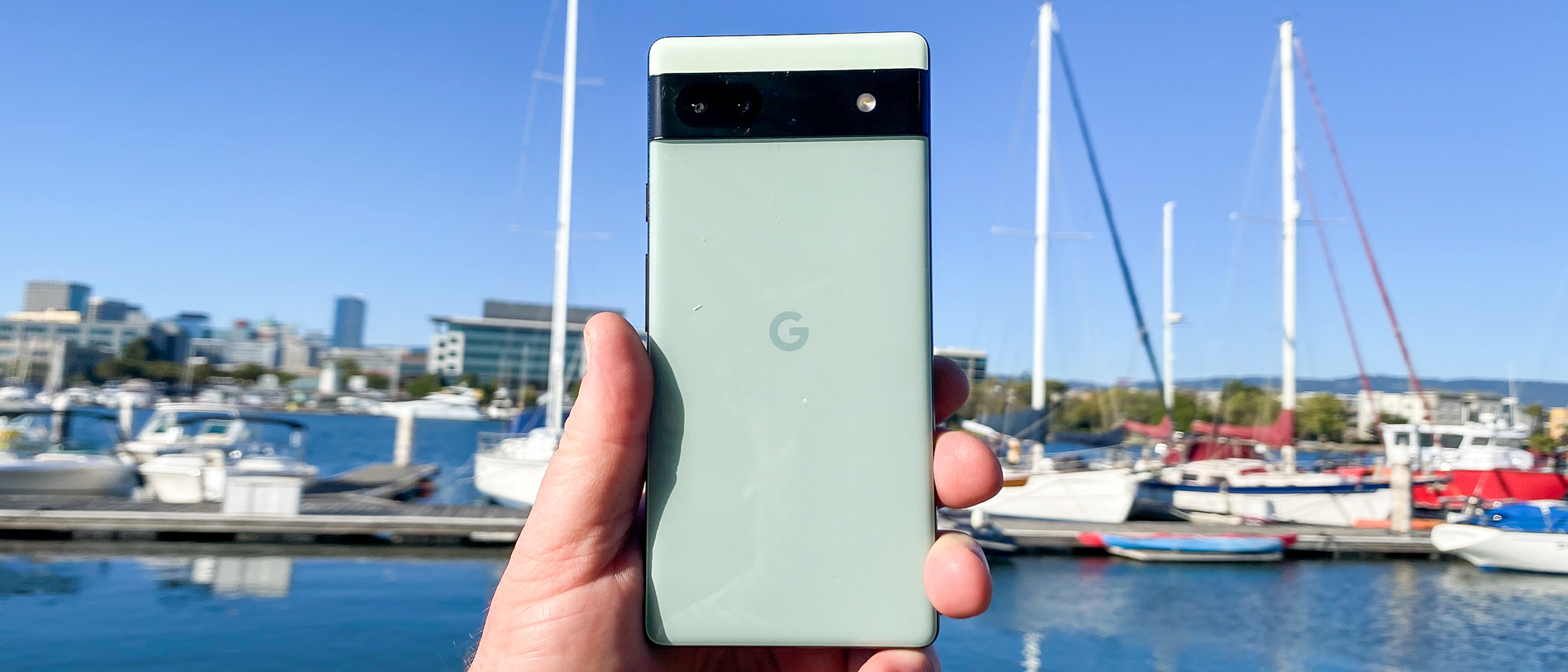Tom's Guide Verdict
Get the Pixel 6a if you want to spend less than $500 on a phone but still want top-notch photos. The Galaxy A53 offers better battery life for the same price, and the iPhone SE is still the low-cost performance champ, but the Pixel 6a is the total package.
Pros
- +
Excellent photos, especially from a sub-$500 phone
- +
Bright display
- +
Compact size for a phone with a 6.1-inch screen
- +
Tensor-powered capabilities at a lower price than the Pixel 6
Cons
- -
Poor performance on our battery test
- -
Cheaper materials than the Pixel 6
Why you can trust Tom's Guide
Price: $449
Screen size: 6.1-inch OLED (2400 x 1080)
Refresh rate: 60Hz
CPU: Tensor
RAM: 6GB
Storage: 128GB
Expandable?: No
Rear cameras: 12.2MP main (f/1.7), 12MP ultrawide (f/2.2)
Front camera: 8MP (f/2.0)
Battery size: 4,410 mAh
Battery life (Hrs:Mins): 6:29
Charging speed: 18W wired
Size: 6 x 2.8 x 0.35 depth inches/152.2 x 71.8 x 8.9 mm
Weight: 6.3 oz/178 g
Colors: Sage, Chalk, Charcoal
The Google Pixel 6a arrived with a big challenge in front of it — reclaim the title of the best cheap phone to buy, particularly for those who prize top-notch cameras above all else.
It wasn't an easy fight for the budget Pixel. Since the Google Pixel 5a arrived at the end of last summer, both Apple and Samsung have come out with low-cost options of their own — the iPhone SE (2022) in Apple's case and the Samsung Galaxy A53. On the lower end of the spectrum, OnePlus' Nord phones are nipping at Google's heels with their extremely low price tags and not-bad-for-the-price feature sets. With all of these phones available at once, there's really no need for you to pay flagship prices to get a capable phone.
The Pixel 6a takes on these other formidable rivals armed with the same Tensor chipset that powers Google's Pixel 6 family, giving it a potential edge. And there's always Google's undeniable strength with mobile photography which has helped past Pixel A Series phones stand out as the best camera phones for bargain hunters.
The Pixel 6a more than carries on that legacy as a top-notch camera phone. And its Tensor system-on-chip adds more tricks to the phone's toolset, as we'll discover in this Google Pixel 6a review.
Google Pixel 6a review: Price and availability
You can get the Pixel 6a for $449 from most locations. That's the same price Samsung charges for its midrange Galaxy A53 and $20 more than the iPhone SE (2020). Buy the phone through Verizon, and you'll pay $499, as Verizon's version of the Pixel 6a supports the carriers mmWave-based 5G network.
Verizon isn't your only option for getting the Pixel 6a through a wireless carrier. As you'd expect, Google's own service, Google Fi, is carrying the phone. So are AT&T and T-Mobile, and you'll even find it in other laces like Visible and the mobile offerings from Comcast and Charter. That's quite a change from the Pixel 5a, which was only available at Google Fi.
The Pixel 6a also enjoys wider availability than its predecessor, which was only released in the U.S. and Japan. The Pixel 6a returns to those countries, but you'll also be able to get it in the U.K., Canada, Germany, Ireland, France, Italy, Spain, Australia, Singapore, Taiwan and India.
Get instant access to breaking news, the hottest reviews, great deals and helpful tips.
The best Google Pixel 6a deals can help you find the phone at a discount, especially now that the Pixel 6a has been on sale for several months. We've seen deals where you can get the Pixel 6a for as little as $299, which is an incredible price for a phone of this quality.
If you're a U.K. buyer, you'll pay £400 for the Pixel 6a. That's cheaper than the iPhone SE (£449), and the same price as the Galaxy A53 and the Europe-exclusive OnePlus Nord 2T. In Australia, Google sells the phone for AU$749.
Google Pixel 6a review: Design
If you're familiar with the new look Google unveiled with its Pixel 6 phones, then the Pixel 6a holds no surprises. The back features the same two-tone design with a horizontal camera bar separating the brighter top portion from the more expansive muted color. In the case of the Pixel 6a, you get to choose from Chalk, Charcoal and Sage. (The latter color was our review unit.)
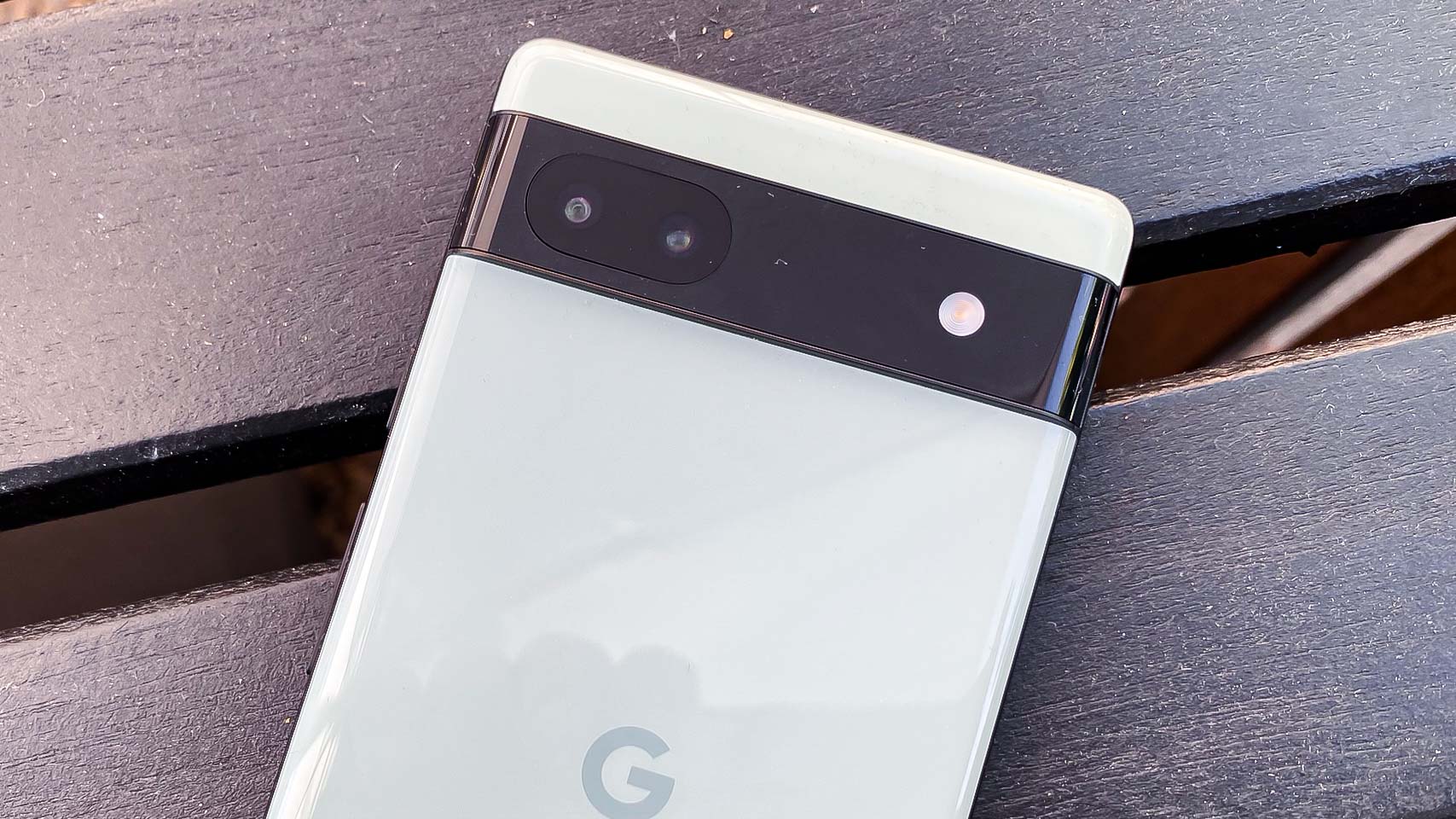
Flip over the Pixel 6a, and it's a slightly smaller version of the regular Pixel 6, right down to the thin bezel surrounding its display and the punch-hole cutout for the selfie cam in the center top of the screen. At 6 x 2.8 x 0.35 inches, the Pixel 6a is a little more compact than its 6.2 x 2.9 x 0.4-inch bigger sibling, though not nearly as small as the 5.5 x 2.7 x 0.29-inch iPhone SE (2022).
The Pixel 6 design is not universally loved, though I happen to think it's a distinctive look in a world of nearly identical smartphones. So I'm pleased that the Pixel 6a offers some visual continuity. As with the regular Pixel 6, I find the sleep button and the volume toggle too close together, so that I wind up hitting one when I mean to use the other. I do miss the colored power button from Pixel models of yesteryear, though.

I've still got the Pixel 6 I reviewed last fall, and holding both it and the Pixel 6a, you can really see how Google saved costs on its budget phone. Whereas the Pixel 6 boasts a glass back and alloy frame, the Pixel 6a features what Google calls a "thermoformed composite back" — that's fancy talk for plastic.
The front of the Pixel 6a uses Corning Gorilla Glass 3 versus the more durable Gorilla Glass Victus on Google's flagship phone. At least, the Pixel 6a sports IP67 water and dust resistance, a nice feature to find in a sub-$500 phone.
Google Pixel 6a review: Display
I appreciate that Google continues to use OLED panels for its lower-cost Pixel A phones when makers of comparably priced handsets often turn to LCD. (Someone draft a memo to Apple about the iPhone SE screen.) OLEDs offer deeper blacks and better contrast, and that comes through when you're watching video or playing games on the Pixel 6a's 6.1-inch display.
Watching Turning Red stream on Disney Plus, the titular panda's orangish red fur displayed vibrantly across the Pixel 6a's screen. More impressively, all those textures that make a Pixar movie stand out rendered in fine detail on the phone's screen, from the lush fur to a green nighted cap worn by one of Meilin's gal pals. Top and bottom speakers produce clear audio as well, though you can muffle those speakers when you're holding the Pixel 6a horizontally to play a game.
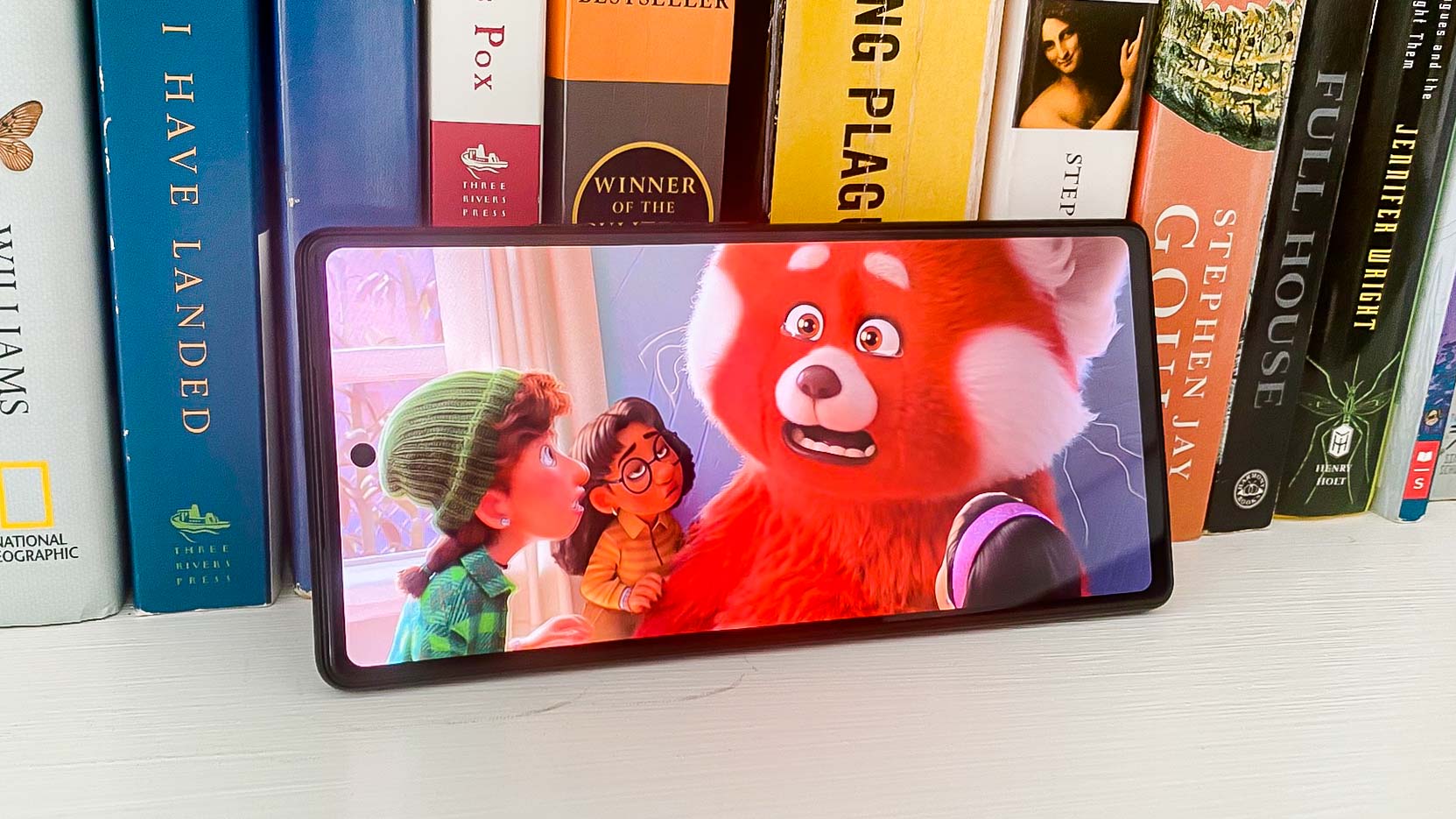
In its color-boosting adaptive mode, the Pixel 6a captures 131% of the sRGB color spectrum, compared to 115% for the iPhone SE. (Change the display setting on the Pixel 6a to the more muted natural, and the sRGB rating drops to a more iPhone-like 111%.) That said, Samsung's Galaxy A53 offers a more colorful display, with a 204% rating in Vivid mode and 123% in Natural.
Colors are far more accurate on the Pixel 6a's display, where the Delta-E rating varies between 0.25 (adaptive) and 0.2 (natural), which is better than Galaxy A53's 0.3-plus rating. (The closer to zero, the more accurate the colors.) The iPhone SE clocks in at 0.21%.
What I most appreciate about the Pixel 6a's display is how bright it can get, especially after the Pixel 5a's relatively dim screen. Using a light meter, we measured peak brightness at 778 nits for the Pixel 6a with adaptive brightness turned on. That outshone both the Galaxy A53 (693 nits) and the iPhone SE (550 nits). That said, in bright sunlight, you may need to adjust the Pixel 6a's brightness upward to make out every detail on the screen.
The phone comes with a 60Hz refresh rate, but there is also a secret hack to unlock a 90Hz display on the Pixel 6a.
Google Pixel 6a review: Cameras
The Pixel 6a maintains the two-camera setup that the Pixel 5a used, but there's a step back in the number of megapixels found on the ultrawide angle lens. The 6a uses a 12MP sensor, compared to 16MP on the Pixel 5a. However, the sensor itself is larger this time around, so the Pixel 6a is likely to let in more light when you turn to its ultrawide angle lens. The main shooter still uses a 12.2MP sensor.

Some might be disappointed by the camera specs on the Pixel 6a, considering how Google beefed up the hardware on the Pixel 6 lineup. That phone uses a 50MP sensor for its main camera and the similarly priced Galaxy A53 turns to a 64MP shooter.
However, the Pixel A series story has always been more about photo processing software and computational photography, and it's these areas that continue to drive the Pixel 6a's camera capabilities. As a result, even with the modest camera specs, the Pixel 6a not only holds its own against rival camera phones, but produces images that could challenge those from much more expensive devices.
For now, let's compare the Pixel 6a to its chief rival for the claim of best camera phone for less than $500 — the iPhone SE. Apple's budget phone has just one rear camera, but like Google, it's able to produce some pretty stellar shots thanks to smart software and image processing. (For a closer look at how these phone compare overall, check out our Google Pixel 6a vs. iPhone SE 2022 face-off, updated to reflect our Pixel testing.)
Both phones did a very capable job capturing the sunflowers growing in my backyard, with the flower standing in sharp contrast to the Japanese maple tree behind it. I'm particularly impressed that both phones kept the sunflower in focus, as a stiff wind was blowing during my camera testing, and I wondered whether that would create blurs in either shot. As it turns out, I needn't have worried.
The images are pretty evenly matched here, with both the Pixel 6a and the iPhone SE recreating the patterns on the sunflower petals and keeping the disc florets in the center nicely distinct. The iPhone SE photo is a little more vibrant, but I give the Pixel 6a points for more accurate colors.
Colors are more evenly matched in these photos of squash at a local vegetable market. The tones of the wooden racks in the background of the Pixel 6a's photo look a bit richer than what the iPhone SE produced, but again, the only separation between these two images comes down to personal preference. I would note that the full shot of the Pixel 6a has a wider viewing area, so you get more details on the margins than you do with the iPhone.
Moving inside, I think the iPhone SE does a better job handling this photo of a meatball sandwich, with a warmer tone than what the Pixel 6a produces. That tone makes the sandwich look more appetizing, with the melted cheese looking pleasantly caramelized and the Italian seasoning dotting the cheese standing out a little bit more. The iPhone SE also did a better job with the light streaming in from a nearby window, which adds some overexposure in the upper right corner of the Pixel 6a photo.
The iPhone SE (2022) lacks an ultrawide lens so to test that part of the Pixel 6a's camera array, I grabbed an iPhone 11 Pro Max. Yes, it's an older phone, but it was still a flagship not too long ago, and I figured it would give us a good idea of how the Pixel 6a can contend with phones that are more powerful on paper.
It contends pretty well, I think, at least in this ultrawide angle shot of a moose statue placed in front of some colorful houseboats. Both photos have some bending around the edges, but it's less prominent in the Pixel 6a shot. I also think Google's did a better job keeping the moose in focus and making it stand out against the marina and the ice plants. In terms of color, it's pretty much a push, which I think speaks well of the Pixel 6a's photo processing capabilities.
The iPhone SE also doesn't come with any sort of Night mode, so the Pixel 6a enjoys quite an edge when the lights are low. You can see how big the disparity is when I set some stuffed animals on a bench lit only by some overhead LED bulbs. There was enough ambient lighting for the iPhone to produce a clear image, but the colors, composition and tone is far superior in the Pixel 6a's shot.
You can even see the trees and plants in the background, whereas they're lost in the darkening murk behind the stuffed animals when the iPhone SE tries to capture the scene.
Just for the sake of science, I captured the same scene with an iPhone 13, which does come with a dedicated night mode but also costs $350 more than the Pixel 6a. Unsurprisingly, the iPhone 13's shot is better where the colors aren't overly warm (though I do think the Pixel 6a handles the background with greater clarity). The point here is that the Pixel 6a photo isn't too far off the mark, and certainly more comparable to the iPhone 13's photo than the disparity in prices between the two phones would have you believe.
Google's photo-processing powers shine when we test out the portrait mode on the Pixel 6a. Not only do I prefer the closer crop on Google's phone, but I think the Pixel does a better job distinguishing my hair from the background blur. In the iPhone SE's effort, part of my beard on the right side of the photo gets caught up in the blur. The Pixel 6a doesn't overly smooth my face, either, like a lot of low-cost phones would, so that's also a mark in Google's favor.
I picked a difficult shot to test out the Pixel 6a's 8MP front camera — the sun was setting just off to the right of the picture frame, running the risk that the end result might be horribly backlit. The Pixel 6a passed the test by keeping the sky properly blue, even it wound up darkening my face. The sky in the iPhone's shot has been washed out, and though my face is brighter than it appears in the Pixel 6a shot, the houses have a yellowish cast to them. The Pixel 6a is clearly more up to the task under these difficult conditions.
It's tempting to focus on still photography when talking about Pixel phones, just because Google is so good at helping its mobile devices take outstanding pictures. But the Pixel 6a boasts some impressive video features, too, starting with the ability to shoot 4K video at up to 60 frames per second. The Tensor chipset powering the phone supports Live HDR+ in 4K for richer colors and a speech enhancement feature for selfie videos keeps ambient noise in check when you're recording.
Google Pixel 6a review: Performance
Google has started making its own chipsets to power its mobile devices, and it's the Pixel 6a's turn to make the same move to Tensor that the Pixel 6 and Pixel 6 Pro did last fall. (The Pixel 7 phones, released after the Pixel 6a, use a newer Tensor chipset.) The goal behind Google's silicon is to specifically include cores dedicated to compute-intensive AI tasks — in other words, the kind of on-device translation and dictation features that make the Pixel experience stand out from other Android phones.
With the focus on AI and machine learning, blazing performance isn't necessarily at the top of Tensor's to-do list. That said, our testing found that the Pixel 6a out-muscled the Android phones in its price range, such as the Exynos 1280-powered Galaxy A53.

The Pixel 6a posted vastly better Geekbench 5 numbers than the Galaxy A53 — 1,057 vs. 745 in the single-core test and a 2,918 vs. 1,888 mismatch in multicore testing. In terms of graphic testing, the Pixel 6a's 41 frames per second result on the 3DMark Wild Life Unlimited benchmark outpaced the Galaxy A53's 13 fps result. The most telling result came from our real-world testing, in which we use Adobe Premiere Rush to transcode a video. The Pixel 6a completed the task in 49 seconds, while the Galaxy A53 needed a little less than 2 minutes.
Unfortunately, Google isn't the only company to take the silicon powering its flagship phones and put inside a lower-cost device. That's a page out Apple's playbook with the iPhone SE, where the 2022 model runs on the same A15 Bionic chipset that powers the iPhone 13 lineup. Since that's the fastest mobile chipset we've tested, you can imagine how a Pixel 6a vs. iPhone SE showdown turned out.
The iPhone SE's 4,482 multicore result on Geekbench and 50-fps score on Wild Life Unlimited handily beat the Pixel 6a. Apple's phone also transcoded the video in 27 seconds, besting the Pixel 6a's time by 22 seconds in our Premiere Rush test. To be fair, to the Pixel 6a and its Tensor chip, lots of phones have a hard time keeping up with the A15 Bionic inside Apple's iPhones. And as we'll get to later, performance is only part of the story with Tensor.
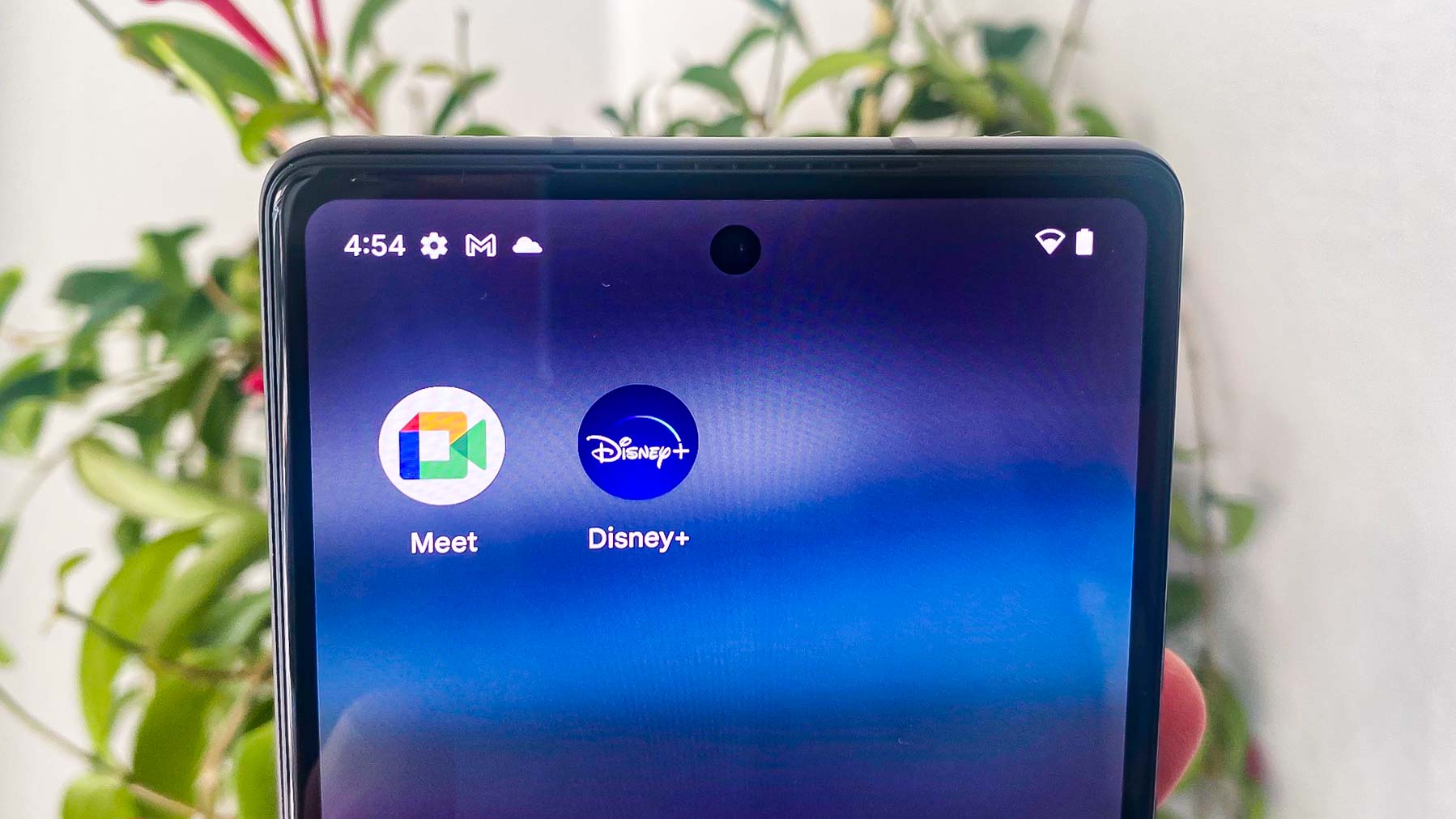
I didn't notice many differences in performance between the Pixel 6a and the Pixel 6, when it came to switching between apps or even playing demanding games like PUBG Mobile. If I have one complaint about Pixel 6a performance, it's that on-screen buttons near the corners of the phone didn't feel as responsive as other areas of the screen, often requiring very precise touches. It's not a huge issue, but it is a noticeable one.
Google Pixel 6a review: Battery life and charging
Battery life has proven to be quite a puzzler with the Pixel 6a. Google promises up to 24 hours of regular usage from the phone, with an Extreme Battery Saver Mode increasing that to 72 hours by turning off features and pausing many apps. That's despite the fact that the Pixel 6a battery is actually smaller than it was on the Pixel 5a — 4,410 mAh vs 4,680 mAh on the Pixel 5a.
Whether it's the smaller battery, the demands of the Tensor chip or some other factor, the Pixel 6a fell flat on our battery test, in which phones surf the web continuously until they run of power. The Pixel 6a lasted an average of 6 hours and 29 minutes, which is more than 3 hours behind the Pixel 5a's result on that same test. Even worse, the Pixel 6a trailed the iPhone SE (2022), and we consider the 9 hour, 5 minute time that Apple's phone produced to be below average for a smartphone.
We've been trying to account for the disparity between our test results and Google's claims and have come up blank thus far. Anecdotally, the Pixel 6a certainly doesn't seem like a likely candidate for our best phone battery life list — after four hours of photo and game testing, a fully charged Pixel 6a had dropped down to 70%. Still, in everyday use, you should be able to make it from sun-up to sun-down without having to charge your phone. Just make sure to charge the phone overnight if you want your Pixel 6a to last the next day.

Speaking of charging, the Pixel 6a supports charging speeds of up to 18W, though you'll have to buy your adapter separately. Using a 15W charger I had handy, I was able to get a drained Pixel 6a to 20% after 30 minutes of charging. Surely, an 18W charger would charged the Pixel 6 up a little bit more, but probably not enough to top the 46% we saw with the Galaxy A53 and its 25W charging.
Google Pixel 6a review: Software and special features
Tensor is the star of the show when it comes to special features, delivering capabilities to the Pixel 6a you'd expect from more premium phones. Magic Eraser makes the move from the Pixel 6 to the Pixel 6a, allowing you to remove unwanted bystanders and objects from your pictures with a tap, as I did with the two passersby in this selfie.
But Magic Erase picks up a new Camouflage feature with the arrival of the Pixel 6a. Now, it's not just about removing distracting objects, but changing their color to blend in more with the background, so the focus remains on the subject of the photo. (You can read about how to use the magic eraser feature on the Google Pixel 6a as well).
Erasing people so easily and effectively from a photo was one of my favorite Pixel 6 features, and I'm glad to see it in the Pixel 6a. I'm less sold on Camouflage, which is heavily dependent on finding just the right scene and the right object to obscure. I tried it with a parked car that had poked its nose into the frame of the above photo of a movie theater's marquee, but I don't think that's the most effective use of Camouflage. Perhaps I'll eventually come across a photo that benefits from this particular set of skills, but I think my Magic Eraser use is going to primarily remove around quick-and-easy removals.
The Tensor-powered features don't stop with a new and slightly improved Magic Eraser. Translation features let you point your camera at text to translate it on the fly, and an Interpreter mode lets you carry on conversations with another person, as the assistant on your Pixel 6a serves as the middleman, translating what each of you says. Translated transcription works on supported languages on the Recorder app as well. And there are now some voice commands that don't even require an "OK, Google" as your phone's wake word.
The Pixel 6a even addresses a big sticking point from the Pixel 6 — the under-display fingerprint sensor. On Google's flagship phone, the fingerprint reader was very laggy, but the 6a's sensor has proven much more reliable in my brief testing. That said, as with the Pixel 6, I find that you have to keep your finger pressed to the screen longer than you might be used to for the phone to consistently unlock.
One thing you may need to watch out for is the Pixel 6a allowing unregistered fingerprints to unlock the phone. Hopefully, this will be solved quickly but it's a critical problem to launch with.
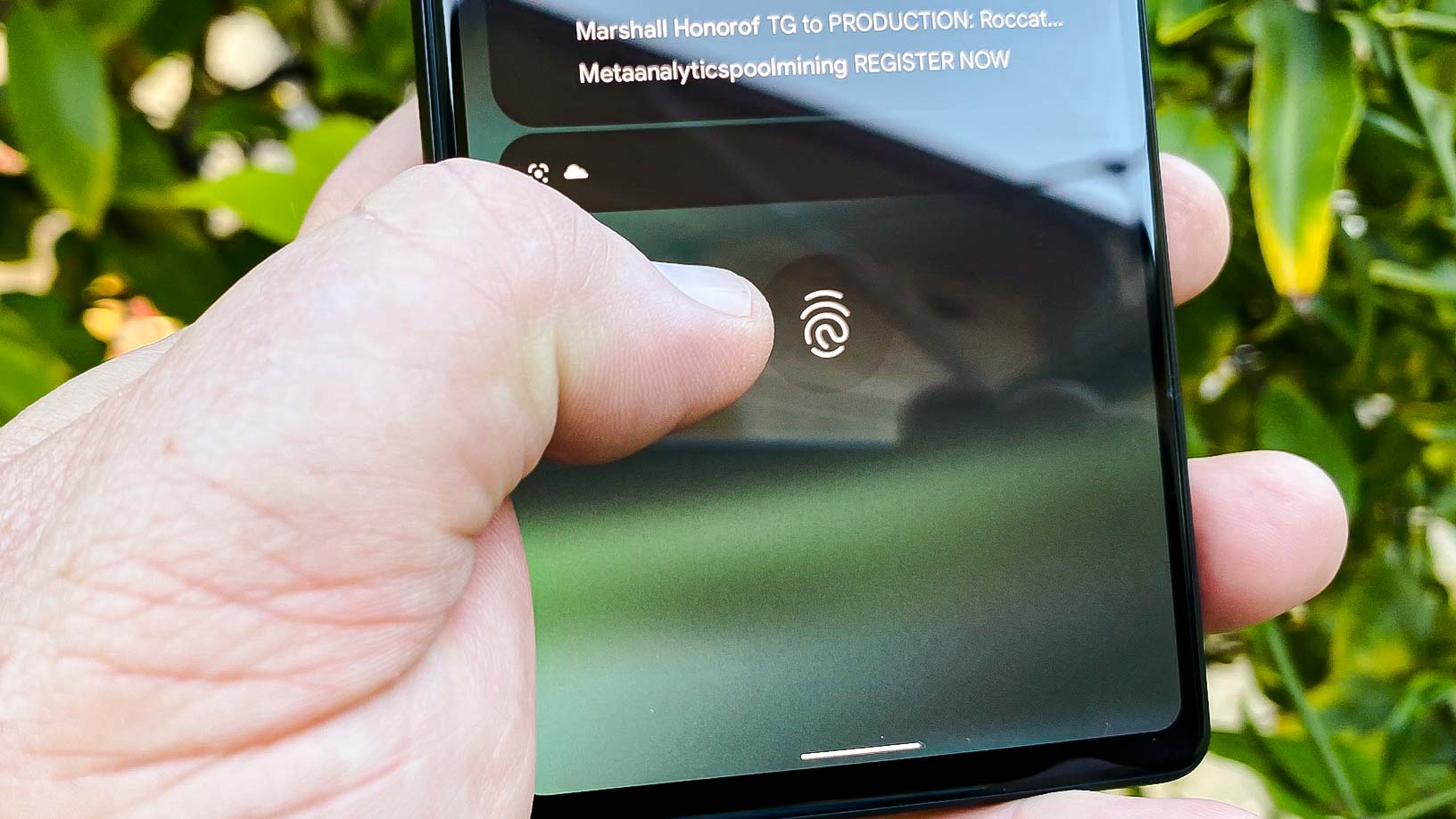
The Pixel 6a debuted with Android 12, but it's already able to run Android 13 — the first of three years of software updates Google guarantees for its budget phone. However, in a world where Samsung now guarantees four Android updates for phones including the Galaxy A53, Google's policy feels a little skimpy. Hopefully, now that it's making its own silicon, Google will get a little more generous with its software updates.
Google Pixel 6a vs. Google Pixel 7
There's another would-be competitor to the Pixel 6a, and for Google, it's a little closer to home. Several months after the Pixel 6a's release, Google released the Pixel 7. As noted above, it features a new Tensor G2 system-on-chip, enabling experiences not even available on the Pixel 6a. And at $599, the Pixel 7 costs only $150 more than the 6a.
So is it worth scrounging up the additional money to buy Google's more expensive — and more recent — smartphone? Our Google Pixel 7 vs. Pixel 6a comparisons looks at the phones side by side. While there a number of differences between the two devices, it boils down to a Pixel 7 vs. Pixel 6a camera face-off — and the Pixel 7 does take better photos than the 6a on average, particularly when it comes to night shots as you can see below.
In other circumstances, the difference is more negligible. Maybe you can spot the differences in this photo of a plate of sushi, but to my eyes, the Pixel 6a's effort is every bit as good as what the Pixel 7 produces.
For that reason, I don't think you're sacrificing all that much if you're set on spending no more than $500 on a phone. So long as you don't care about having the latest Tensor chip or a more capable camera phone in low light settings, you can buy the less expensive Pixel 6a with confidence.
Google Pixel 6a review: Verdict
Puzzling battery performance aside, the Pixel 6a is hard to beat if you're looking for a great phone for under $500. The phone has a compelling look, a bright display and better performance than its closest Android archrival, the Galaxy A53. It's once again one of the best camera phones among midrange devices, capable of competing with phones that are much more expensive. And that Tensor chipset means your budget phone is capable of doing much more than the low-cost competition.
Really, the bigger debate is that Pixel 7 vs. Pixel 6a question raised above. The Pixel 7 is a better phone, justifying the $150 price difference. But if you're dead set on getting a good phone for a low cost, it's hard to top the value the Pixel 6a delivers.
So if you've been waiting for a great camera phone at a great price, there's no need to wait any longer. The Pixel 6a delivers on just about every front.
Next: If you do decide to buy a Pixel 6a, you can also check out the best Google Pixel 6a cases for your new phone.
Philip Michaels is a Managing Editor at Tom's Guide. He's been covering personal technology since 1999 and was in the building when Steve Jobs showed off the iPhone for the first time. He's been evaluating smartphones since that first iPhone debuted in 2007, and he's been following phone carriers and smartphone plans since 2015. He has strong opinions about Apple, the Oakland Athletics, old movies and proper butchery techniques. Follow him at @PhilipMichaels.
